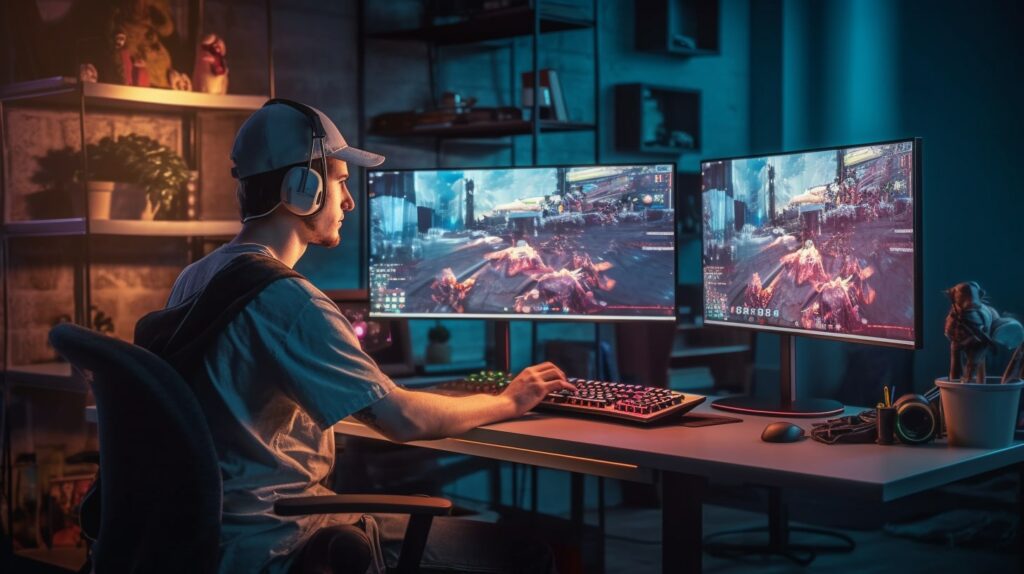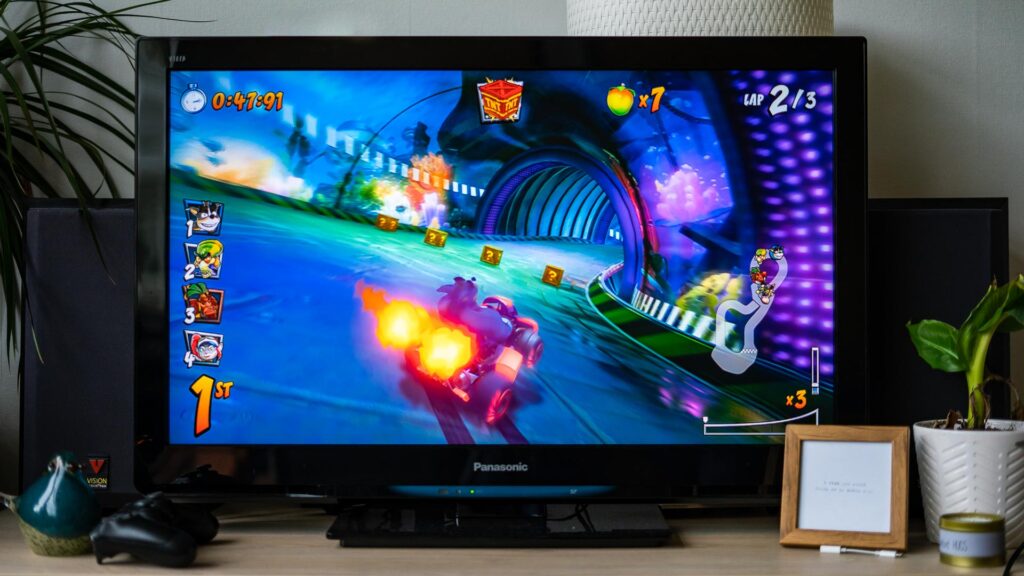Meet this game changer!

Ah, the world of gaming and display technology. 🎮 What a party! But wait a minute, have you ever heard of “VRR”? Or Variable Refresh Rate? It’s a game changer for your screen. VRR helps to vary the refresh rate of your screen depending on what is currently happening in your game.
What exactly is VRR and what does it mean for your gaming experience? Stick around, because in this article we reveal all the ins and outs of VRR. From how it works and the difference with V-Sync, to the benefits for gamers and the application in televisions and monitors. So let’s dive deeper into the wonderful world of VRR!
Key points summarized:
- VRR (Variable Refresh Rate) provides a smoother gaming experience by dynamically adjusting your screen’s refresh rate to match the output of your game console or PC.
- VRR is preferred over V-Sync because of its flexibility, reducing input lag and preventing screen tearing.
- The latest game consoles, such as Xbox Series X/S and PlayStation 5, support VRR, resulting in smoother gameplay and faster responses.
VRR explained: the basics of variable refresh rate
VRR, or Variable Refresh Rate, is a technology that ensures that the refresh rate of your screen is dynamically adjusted to the output of your game console or PC.
Basically, it helps to vary your screen’s refresh rate depending on what’s happening in your game at the time.
This technology is especially important in the context of gaming and display technology. As a gamer, you naturally want the smoothest possible gaming experience, without stuttering or jerky images. And let VRR play a major role in that! ️
How VRR works: screen and game console synchronization
VRR keeps your display’s refresh rate in sync with your game console’s output.️ It’s like your screen and console are performing a kind of dance, perfectly coordinating every move. 🕺
Imagine playing a racing game and taking a sharp turn. The game console may have a lower output at that time because the image changes quickly. VRR ensures that your screen immediately absorbs and adapts to that change, so that you do not experience jerky images.

VRR vs V-Sync: What’s the difference?
V-Sync, or Vertical Synchronization, is another technology that is also intended to prevent screen tearing. But there are some key differences between VRR and V-Sync.
First, V-Sync often suffers from input lag as it waits for the next frame before refreshing the screen.
With VRR you will not be bothered by this, because the screen immediately adapts to the output of your game console. In addition, V-Sync can only work with fixed refresh rates, while VRR is flexible and adapts to the situation.
This makes VRR preferable to V-Sync for gaming as it provides a smoother gaming experience with no input lag and more flexibility.
The benefits of VRR for gamers
VRR offers a number of important benefits to gamers, all of which contribute to a better gaming experience.
Firstly, VRR provides smoother images, because it prevents screen tearing and stuttering. This is especially important in fast-paced games, where the image is constantly changing and you need to be able to react quickly. 🚀
In addition, VRR helps to reduce input lag, allowing you to react faster to what is happening in the game. This can make the difference between winning and losing, especially in competitive games!
Smoother gameplay without screen tearing
Screen tearing is an irritating problem that can occur when your screen’s refresh rate is out of sync with your gaming console’s refresh rate.
The result? A blurry, unpleasant image that can seriously ruin the gameplay. Fortunately, VRR is here to save the day!
By matching your screen’s refresh rate to your console’s framerate, VRR prevents screen tearing and ensures smooth, fluid gameplay.
For example, you can take sharp turns in racing games without the image faltering or becoming blurry. In short, VRR takes your gaming experience to the next level!
Less input lag for faster responses
As a gamer you want to react as quickly as possible to what is happening in the game. However, input lag can throw a spanner in the works, slowing down your reactions and reducing your performance. VRR comes to the rescue again by reducing input lag!
VRR ensures that your screen and game console are better aligned, so that your input is processed faster.
This means you can react faster to enemy attacks in first-person shooters or reach just that one platform in a platform game. In short, a lower input lag means better performance and more gaming fun! 🏆
VRR in the world of televisions and monitors
In recent years, VRR has undergone a huge evolution from being a niche feature for gaming monitors to becoming a standard option on many modern TVs.
Major VRR milestones and developments include the emergence of Adaptive Sync technologies, such as AMD FreeSync and NVIDIA G-Sync, and the introduction of HDMI 2.1.

HDMI 2.1 and the rise of VRR support
HDMI 2.1 is a major update to the HDMI standard that enables VRR support on televisions and monitors. This update has had a major impact on VRR adoption as more and more manufacturers have started adding HDMI 2.1 ports to their devices.
Besides VRR, HDMI 2.1 also offers other benefits such as higher bandwidth, 8K resolution and improved audio formats. All this contributes to a better gaming and entertainment experience!
Popular VRR-enabled TVs: LG CX oled and Samsung Q80T qled TV
There are plenty of VRR-capable TVs on the market today, but two popular models are the LG CX OLED and the Samsung Q80T QLED TV. Both TVs offer excellent picture quality and have HDMI 2.1 ports, making them perfect for gamers looking for a VRR experience.
The LG CX OLED is known for its deep blacks and vibrant colors, while the Samsung Q80T QLED TV impresses with its brightness and color volume.
Both TVs also offer low input lag and fast response times, making them ideal for fast-paced, action-packed games. In short, with these TVs you get the best out of your VRR-capable game console!️
VRR and the latest game consoles
The latest generation of game consoles, such as the Xbox Series X/S and PlayStation 5, support VRR, allowing you to enjoy the benefits of VRR while gaming. This means smoother gameplay, less screen tearing and faster responses.
The Xbox Series X/S and PlayStation 5 use powerful hardware and advanced technologies to give you the best possible gaming experience. VRR support is just one of the many features that make these consoles so appealing to gamers looking for the ultimate gaming experience. 🏅
Xbox Series X/S and PlayStation 5: VRR support and capabilities
The Xbox Series X/S and PlayStation 5 are the latest generation of gaming consoles, and they both have VRR support to enhance the gaming experience. With the Xbox Series X/S, VRR is supported over HDMI 2.1 and is fully compatible with both AMD FreeSync and NVIDIA G-Sync technologies.
The PlayStation 5 also supports VRR, but it’s important to note that this feature isn’t currently available and is expected in a future software update.
An example of how VRR improves the gaming experience on these consoles is by reducing screen tearing and input lag. This makes games smoother and more responsive, which is especially important in fast-paced and competitive games.

Adaptive Sync Technologies: AMD FreeSync and NVIDIA G-Sync
Adaptive Sync technologies, such as AMD FreeSync and NVIDIA G-Sync, are designed to enhance and enhance the VRR experience.
These technologies work by synchronizing the monitor’s refresh rate with the game console or PC’s frame output, resulting in smoother and more consistent gameplay.
How Adaptive Sync improves the VRR experience
The role of Adaptive Sync in improving the VRR experience is crucial. Not only does it eliminate screen tearing, but it also reduces input lag and can even improve the monitor’s energy efficiency.
For example, G-Sync and FreeSync with USB-C allow users to enjoy the benefits of Adaptive Sync over a USB-C connection.
Frequently Asked Questions about VRR
Is VRR just for gaming or does it have other benefits as well?
While VRR is primarily associated with gaming, there are other benefits and uses as well. For example, when watching movies or videos with variable frame rates, VRR can provide smoother playback.
It can also be helpful with the best monitor for working from home, where a smoother display of visual content can contribute to better concentration and productivity.
What are the minimum requirements for a VRR-capable setup?
The minimum requirements for a VRR-enabled setup are a VRR-capable monitor or TV and a VRR-capable game console or PC. It’s also important to have the right connections, such as HDMI 2.1 or DisplayPort, depending on the devices you’re using.
When choosing the best 24 inch monitor for a VRR setup, it’s important to consider compatibility and supported technologies.
How do I know if my TV or monitor supports VRR?
To check whether your TV or monitor supports VRR, you can consult the product specifications and manuals. This information can usually be found on the manufacturer’s website or in the documentation that comes with it.
It’s important to check device compatibility for best results, especially when looking for the best photo editing monitor with VRR support.
Does using a dual monitor affect the fps?
Using a dual monitor can affect the fps depending on the specs of your PC or game console.
In general, adding a second monitor will require more computing power, which can lead to a drop in fps in some cases. Read more about this topic in our article on “does a dual monitor affect fps?”.
What are some solutions for ghosting when using FreeSync?
Ghosting is an issue that can occur when using FreeSync, where a “ghostly” image from previous frames remains on the screen.
Some solutions for reducing or eliminating ghosting when using FreeSync are adjusting the monitor settings, such as the overdrive function, or updating the graphics card drivers.
Read our article on how to fix FreeSync ghosting for more information and tips on how to tackle this problem.
What are the best 144Hz monitors for gaming?
Some of the best 144Hz monitors suitable for gaming include the ASUS VG279Q, the LG 27GL850-B, and the AOC CQ27G2.
These monitors offer fast refresh rates, low input lag and excellent color reproduction, resulting in an immersive and responsive gaming experience. Check out our recommendations in the article on the best 144Hz monitor for more information and other options.

Conclusion
We’ve talked about the ins and outs of VRR and why it’s such an important technology for gamers and display enthusiasts. It is now clear that VRR can make a big difference to your gaming experience by providing smoother visuals, less screen tearing and lower input lag.
The latest gaming consoles, such as the Xbox Series X/S and PlayStation 5, already support VRR, making it a must-have technology for the modern gamer. But let’s not forget that VRR can also be useful for other applications, such as watching movies or working on a monitor.
So, whether you’re an avid gamer or just looking for a smooth, seamless viewing experience, VRR is the technology to watch! Now that you’re fully informed, it’s time to upgrade your VRR experience and experience the difference for yourself. Have fun gaming!️